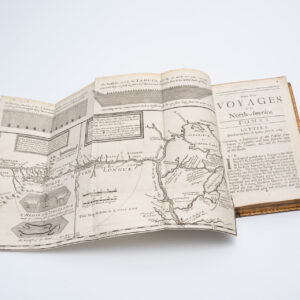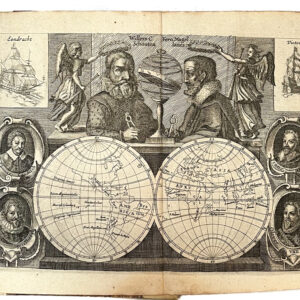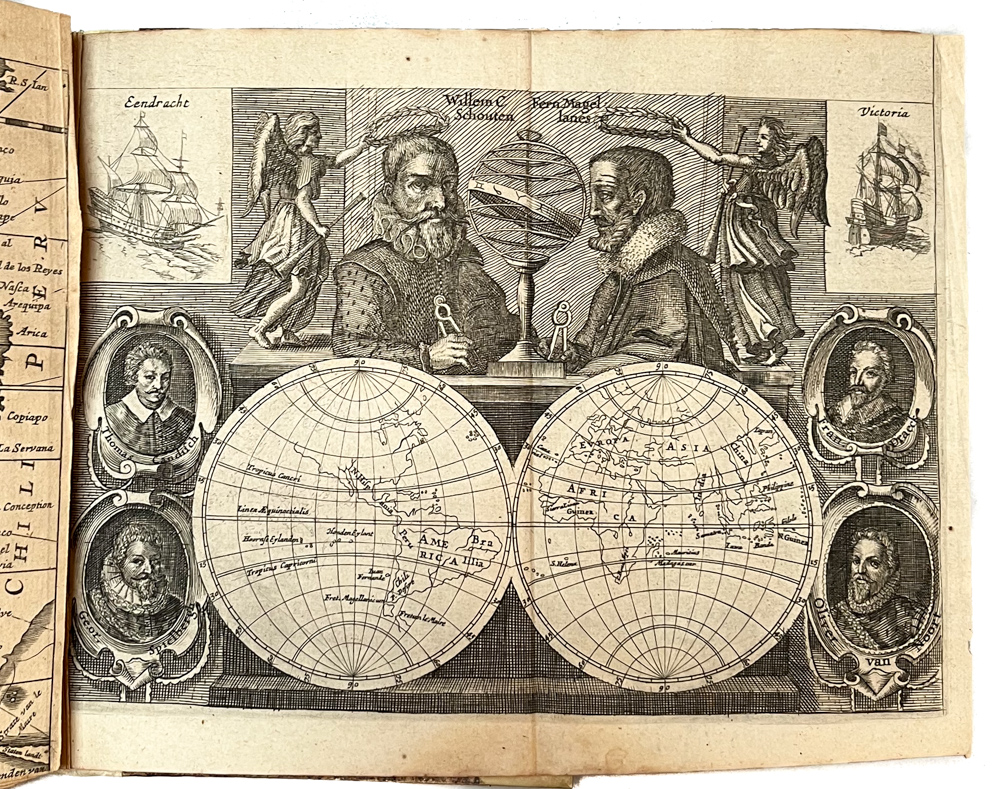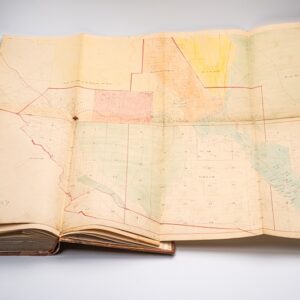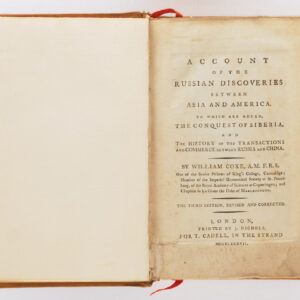A superb and fully intact Ptolemaic Geography from 16th century Venice, constituting a cornerstone in the history of cartography.
Geografia di Claudio Tolomeo Alessandrino Tradotta di Greco nell’Idioma Volgare Italiano da Girolamo Ruscelli
Out of stock
Description
A superb fourth edition of Ruscelli’s updated and expanded Ptolemaic Geography, edited by G. Rosaccio. Complete with a handsome contemporary vellum binding and ink lettering. Excellent condition.
One of the many consequences of the Crusades was an interaction between Christendom and the Islamic world that lead to Europe rediscovering much of the Classical heritage that was lost in the religious rigor of the Middle Ages. Among the most important ancient writers to be taken up again was the geographer Claudius Ptolemy, who had authored a seminal work on the world’s composition, entitled Geografia. In late 14th century Italy, Ptolemy’s Geography was translated and reprinted, and soon thereafter new versions were compiled, in which schematic maps were drawn-up to compliment the original textual descriptions. This revival of Ptolemaic thinking was strongest in the mercantile cities of Italy, where it became the dominant vision of world geography. That is, until the Age of Exploration began challenging Classical conceptions of the world.
Neatline’s copy of Ptolemy’s Geographia is a magnificent late sixteenth-century edition from Venice, the hometown of pioneer explorers like Marco Polo and Sebastian Cabot. It was produced towards the end of the age of Ptolemaic geography. By the time of its publication in 1599, the New World had long been discovered, just as the Pacific had been crossed, the Cape of Good Hope had been rounded, and substantial parts of Asia had been mapped. Most of these new realities simply did not align with Ptolemy’s descriptions of the world, and so Italy’s geographers were forced to adapt and reconsider their model. The incongruence between the described and the observed was resolved by adding new maps, which both showed the latest discoveries and tested new geographical concepts.
This revisionary approach was a crucial step towards building an accurate geography and is perfectly exemplified in this tome by noted Venetian mapmaker and mathematician, Girolamo Ruscelli (1518–1566). Ruscelli was perhaps the most progressive Ptolemaic geographer of his time and his atlas is among other things famous for its mapping of the Americas, as well as its willingness to revise and reconsider the concept of a great southern continent. The latter is demonstrated in four distinct maps, which all delineate its features in ways that are quite distinct from Ruscelli’s 1574 edition of Ptolemy.
The work is completely intact, containing a total of 69 engraved double-page maps with wide margins. These can be subdivided into four world maps (including one Ptolemaic view), seven maps of America, twenty-eight maps of Europe, ten maps of Africa, and twenty maps of Asia. Within the entire corpus, 27 maps can be classified as Ptolemaic, reflecting a Classical vision of the world, while no less than 42 constitute ‘new maps’, reflecting an informed Renaissance perspective on the world.
This quarto-sized volume consists of all three parts in one volume. Bound tightly in contemporary vellum and titled with black ink on the spine, ours is the fourth edition, which was edited by Giuseppe Rosaccio (c. 1530 – 1620) and published by the heirs of M. Sessa in 1598-99. We know that Rosaccio, a Venetian geographer and scholar, revised the copperplates of an earlier Ruscelli edition, augmenting the atlas with at least five new plates, as well as adding typical 16th century decorative features such as ships, sea monsters, and pictorial topography.
In general, this is a most excellent example of a Ptolemaic Geography from the Late Renaissance. It not only embodies a concept of the world that is millennia old, but also reflects how the Renaissance fostered a willingness among Europe’s intelligentsia to reconsider even the firmest of concepts. It is this intellectual flexibility; this openness to being wrong, that constitutes the foundation for our civilization’s success. Nowhere is this distinctly human trait brought out more exquisitely than in this extraordinary piece of Italian Renaissance culture.
Cartographer(s):
Girolamo Ruscelli (1518–1566) was an Italian mathematician, polygraph, and cartographer active in Italy during the early 16th century. He was born around 1518 in Viterbo to a family of minor nobility and humble origins. Throughout his life, Ruscelli moved around, living all over Italy. He started in Aquilea, but his work soon drew him to more important centers of learning. He moved first to Padua, and around 1540, he settled in Rome, where he founded his Accademia dello Sdegno. Around 1545, Ruscelli left Rome for Naples, and in 1548 he finally settled in the city that would make him most famous, Venice.
While posterity primarily remembers Ruscelli as one of the most important cartographers of the Venice School, his primary source of income came from publishing – both his works and copying the work of others. While he wrote on a broad range of subjects himself, the works plagiarised from others were often published by his partner, Plinio Pietrasanta. This lucrative relationship lasted until 1555 when Ruscelli was arrested and tried by the Inquisition for re-publishing a satirical poem by Pietrasanta without his formal permission. Any confrontation with the Inquisition was unpleasant enough, but Ruscelli may have been particularly susceptible to pressure because his wife’s family entertained Protestant sympathies. His brother-in-law was burned at the stake in Rome some years later.
The relationship with Pietrasanta had nevertheless soured, and the publishing firm was soon closed. Instead, Ruscelli partnered up with another Venetian publisher, Vincenzo Valgrisi. It was with Valgrisi that Ruscelli published his famous Ptolemaic Geografia in 1561. This atlas contained sixty-nine engraved maps sporting the latest ideas in Italian cartography. Despite containing some of the latest cutting-edge ideas about the world’s composition, Ruscelli’s atlas also drew heavily on earlier works. Forty of the 69 maps in Ruscelli’s atlas were copied almost directly from Giacomo Gastaldi’s Geografia from 1548.
Despite Ruscelli’s fame as a cartographer, he also achieved considerable recognition under his pseudonym Alessio Piemontese. His greatest success in this regard came the same year as his arrest (1555), with the publication of De Secreti del Alessio Piemontese. In this book of alchemy, Ruscelli reveals himself as a true Renaissance man, dabbling proficiently in multiple disciplines at the same time. His ‘Secrets‘ contained instructions on how to make everything from alchemical compounds and medicines to cosmetics and dyes. The work was so popular that it was re-issued numerous times over the next two centuries, and translated into French, English, German, Latin, Dutch, Spanish, Polish, and even Danish.
Giuseppe RosaccioLittle is known about the life of Giuseppe Rosaccio (c. 1530 – 1620), a Venetian geographer and scholar.
Condition Description
Collation complete.
Quarto. Three parts in one volume, with 69 double page copper-engraved maps, several woodcut diagrams in text; some occasional light toning and spotting.
Contemporary vellum binding with ink lettering. Quite clean, no tears; binding tight with some soiling. Back bottom right corner with a small chip. Generous margins.
References
Shirley, R. W. Maps in the Atlases of the British Library, T.PTOL-10f/g;T.PTOL-12b; Shirley, R. W. The Mapping of the World, No. 110, 111, 133, 217; Burden, P.D. The Mapping of North America No. 86.
